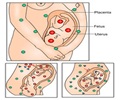A new study reveals that the risk of small-for-gestational-age (SGA) increases during a second pregnancy if babies born during the first pregnancy have been found to be SGA as well.

Infants who are small for gestational age (birth weight below the fifth percentile) are a heterogeneous group comprised of infants that have failed to achieve their growth potential (fetal growth restriction; FGR) and infants who are constitutionally small. SGA infants are at increased risk for perinatal mortality and adverse perinatal and health outcomes later in life.
"The main strength of this study was the size and composition of the cohort," said B J Voskamp, MD. "Data were derived from a large, well-maintained, population-based national perinatal registry."
The study was performed in a prospective nationwide cohort with the use of the Netherlands Perinatal Registry (PRN). The PRN consists of population-based data that includes information on pregnancy and delivery of 96 percent of pregnancies in the Netherlands. From this, they studied a cohort of women who delivered two subsequent singleton pregnancies (first and second deliveries) in the Netherlands from Jan. 1, 1999, through Dec. 31, 2007.
The primary outcome measure was SGA. Researchers registered demographic and obstetric characteristics including maternal age, parity, ethnicity, and socioeconomic status (SES).
Cases were analyzed in total and stratified into two groups: women with and without a hypertensive disorder in their first pregnancy. The analysis was stratified by gestational age at delivery in the first pregnancy in 3 groups: very preterm, late preterm, and full-term.
Further, the risk of SGA recurrence in women with hypertensive disorder in their first pregnancy was smaller than in women who did not. However, the risk of "de novo" SGA in the second pregnancy was higher for those with hypertensive disorder than their counterparts.
Source-Eurekalert
 MEDINDIA
MEDINDIA



 Email
Email










